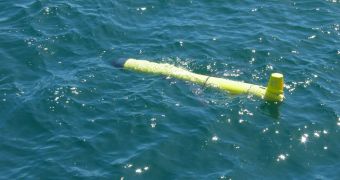Last year marked the first time an underwater robotic vehicle (glider) crossed the Atlantic Ocean, demonstrating that doing so is possible. Several months after, other gliders were used to quell the oil spill caused by the Deepwater Horizon drilling rig.
Today, December 9, the Smithsonian National Museum of Natural History's Sant Ocean Hall will inaugurate an exhibit whose centerpiece will the the Rutgers University-operated glider that managed to cross the ocean on its own.
This particular glider is called the US Integrated Ocean Observing System (IOOS®), but has been nicknamed the Scarlet Knight by the scientists and students who operated it.
The robot left the coast of New Jersey to cross the ocean, and was recovered by the Spanish Port Authority (Puertos Del Estado) seven months later, off the coast of Baiona.
The city is filled with historical significance, for both Europe and the US. Five centuries ago, this is where Christopher Columbus landed on his ship Pinta, bringing the news that the New World exists.
“Gliders sample the ocean in places it is impractical to send people and at a fraction of the cost. Using robots to collect scientific data is the wave of the future in terms of ocean observing,” explains the director of the US IOOS Program, Zdenka Willis.
There are a variety of tasks gliders can be used for, including measuring oceanic salinity, density, currents, and temperatures. These studies can be conducted both on the surface and at various depths.
This was made crystal clear during the BP oil spill, which began in April and ended only months later. A fleet of gliders equipped with oil sensors surveyed the Gulf of Mexico at different depths, keeping track of the underwater spread of oil.
Naturally, scientists still had to sample the water to confirm or infirm the stuff was there, but the gliders helped reduce the targeted area considerably.
“New technologies give us greater insight into how the ocean works. The trans-Atlantic glider, in particular, helped reduce uncertainty in some of our climate models,” explains Richard L. McCormick.
“We are thrilled to work with IOOS to enhance this understanding at such a critical time for our planet,” adds the expert, who is the president of the Rutgers University.
“The Office of Naval Research is proud to join in celebrating this accomplishment,” adds the chief of Naval Research, Rear Admiral Nevin P. Carr Jr.
“We are always excited to see Navy basic research investments, such as this one in autonomous ocean sensing, pay off for the Navy and the ocean science community,” he adds.
“These vehicles provide critical knowledge for naval operations as well as data that will assist in achieving a better understanding of the complex global marine environment,” Carr Jr. concludes.

 14 DAY TRIAL //
14 DAY TRIAL //